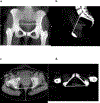After shoulder dystocia: managing the subsequent pregnancy and delivery
- PMID: 17531900
- PMCID: PMC9059257
- DOI: 10.1053/j.semperi.2007.03.009
After shoulder dystocia: managing the subsequent pregnancy and delivery
Abstract
Among risk factors for shoulder dystocia, a prior history of delivery complicated by shoulder dystocia is the single greatest risk factor for shoulder dystocia occurrence, with odds ratios 7 to 10 times that of the general population. Recurrence rates have been reported to be as high as 16%. Whereas prevention of shoulder dystocia in the general population is neither feasible nor cost-effective, intervention efforts directed at the particular subgroup of women with a prior history of shoulder dystocia can concentrate on potentially modifiable risk factors and individualized management strategies that can minimize recurrence and the associated significant morbidities and mortality.
Figures

Similar articles
-
Recurrent Shoulder Dystocia: Risk Factors and Counseling.Clin Obstet Gynecol. 2016 Dec;59(4):803-812. doi: 10.1097/GRF.0000000000000229. Clin Obstet Gynecol. 2016. PMID: 27662541 Review.
-
Shoulder Dystocia: Incidence and Risk Factors.Clin Obstet Gynecol. 2016 Dec;59(4):791-794. doi: 10.1097/GRF.0000000000000227. Clin Obstet Gynecol. 2016. PMID: 27662540 Review.
-
Complications of labor and delivery: shoulder dystocia.Prim Care. 2012 Mar;39(1):135-44. doi: 10.1016/j.pop.2011.12.002. Epub 2012 Jan 4. Prim Care. 2012. PMID: 22309586 Review.
-
Shoulder dystocia: an analysis of risks and obstetric maneuvers.Am J Obstet Gynecol. 1993 Jun;168(6 Pt 1):1732-7; discussion 1737-9. doi: 10.1016/0002-9378(93)90684-b. Am J Obstet Gynecol. 1993. PMID: 8317515
-
Shoulder dystocia.Br J Obstet Gynaecol. 1998 Aug;105(8):811-5. doi: 10.1111/j.1471-0528.1998.tb10223.x. Br J Obstet Gynaecol. 1998. PMID: 9746371 No abstract available.
References
-
- Acker DB, Sachs BP, Friedman EA. Risk factors for shoulder dystocia. Obstet Gynecol 1985;66:762–8. - PubMed
-
- Benedetti TJ, Gabbe SG. Shoulder dystocia- A complication of fetal macrosomia and prolonged second stage of labor with midpelvic delivery. Obstet Gynecol 1978;52:526–9. - PubMed
-
- Berard J, Dufour P, Vinatier D, Subtil D, Vanderstichele S, Monnier JC et al. Fetal macrosomia:risk factors and outcome; a study of the outcome concerning 100 cases >4500 g. Eur J Obstet Gynecol Reprod Bio 1998;77:51–9. - PubMed
-
- Hassan AA. Shoulder dystocia: Risk factors and prevention. Aust NZ J Obstet Gyn 1988;28:107–9. - PubMed
-
- Nesbitt T, Gilbert W, Herrchen B. Shoulder dystocia and associated risk factors with macrosomic infants born in California. Am J Obstet Gynecol 1998;179:476–80. - PubMed
Publication types
MeSH terms
Grants and funding
LinkOut - more resources
Full Text Sources
Medical

